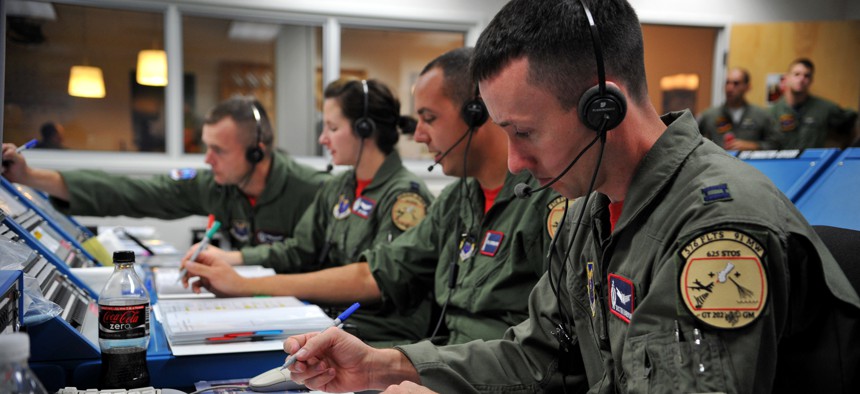
Members of the 576th Flight Test Squadron conduct pre-flight operations for a Minuteman III ICBM at Vandenberg Air Force Base, Calif. Pentagon officials are standing up a new facility to back up Vandenberg’s Joint Space Operations Center. U.S. Air Force/Senior Airman Andrew Lee
Pentagon Rushing to Open Space-War Center To Counter China, Russia
Prepping for war in orbit, the military is honing tactics and building a new center to coordinate defense and development.
The Pentagon and intelligence community are developing war plans and an operations center to fend off Chinese and Russian attacks on U.S. military and government satellites.
The ops center, to be opened within six months, will receive data from satellites belonging to all government agencies, Deputy Defense Secretary Robert Work said Tuesday at the GEOINT symposium, an annual intelligence conference sponsored by the United States Geospatial Intelligence Foundation.
“[W]e are going to develop the tactics, techniques, procedures, rules of the road that would allow us … to fight the architecture and protect it while it’s under attack,” Work said. “The ugly reality that we must now all face is that if an adversary were able to take space away from us, our ability to project decisive power across transoceanic distances and overmatch adversaries in theaters once we get there … would be critically weakened.”
Work also said that Air Force Secretary Deborah James would soon be named the “principal space advisor” to Defense Secretary Ashton Carter, where she will to provide “independent advice separate from the consensus process of the department.”
Senior officials at the Pentagon and Office of the Director of National Intelligence are still finalizing details of the new center, which will back up the military’s Joint Space Operations Center at Vandenberg Air Force Base, California.
The center will help the military and government coordinate their preparations for and responses to any attack, said Lt. Cmdr. Courtney Hillson, a spokeswoman for Work.
The hope is that it will also shore up the U.S. technological advantage over China and Russia—the latter of which Work said “represents a clear and present danger”—by coordinating the development of new capabilities. In particular, Work said, the Defense Department intends to “double down” on geospatial intelligence.
“We want to be able to establish patterns of life from space. We want to know what the unusual looks like,” he said. “If, all of a sudden, a lot of cars show up in a parking lot of an adversary’s missile plant, we want to know about it and we want to know about it quickly. If, suddenly, small boats are swarming in the Gulf or pirates are starting to congregate off Aden, we want to know.”
“If Russian soldiers are snapping pictures of themselves in war zones and posting them in social media sites, we want to know exactly where those pictures were taken,” Work said, alluding to a 24-year-old Russian soldier named Alexander Sotkin who posted photos of himself operating Russian-made military equipment inside Ukraine last July.
“If [we see] a ship that we suspect might be carrying illicit materials, we want to know how deep it’s sitting in the water so we can know how much cargo it’s holding,” said Work. “On top of all of that, we need this information more quickly than in the past.”
Space, once a “virtual sanctuary,” must now "be considered a contested operational domain in ways that we haven’t had to think about in the past,” he said.
In 2007, China shot down one of its own weather satellites, creating a large field of debris that still orbits Earth. In 2013, China launched a more powerful rocket that could threaten U.S. satellites currently beyond range of ground-launched missiles.
“We must be prepared now to prevail in conflicts that extend into space,” Work said.
Space Projects
One of several changes to space strategy and posture that have emerged from a year-long Pentagon review, the new facility is part of a $5 billion boost for space security included in the Defense Department’s 2016 budget request. Among the other high-priority projects in the request are $21 million for Navy communications satellites, up from $11 million the previous year; and $100 million for space-based reconnaissance, up from $78 million the previous year. Proposed funding for Air Force space situational awareness rose from $9 million to $32 million.
But it may prove easier to alter budgets than the way the military thinks about space. “I’m wanting and pulling and looking for those new ideas and trying to change the culture that is really very comfortable with the status quo right now,” Gen. John Hyten, the head of Air Force Space Command, said in April. His 40,000-person command runs most of the Pentagon’s space projects, the vast majority of military satellites, and all of the large U.S. reconnaissance and communications satellites.